Loading AI tools
Total lunar eclipse of 20 February 2008 From Wikipedia, the free encyclopedia
A total lunar eclipse occurred at the Moon’s descending node of orbit on Thursday, February 21, 2008,[1] with an umbral magnitude of 1.1081. A lunar eclipse occurs when the Moon moves into the Earth's shadow, causing the Moon to be darkened. A total lunar eclipse occurs when the Moon's near side entirely passes into the Earth's umbral shadow. Unlike a solar eclipse, which can only be viewed from a relatively small area of the world, a lunar eclipse may be viewed from anywhere on the night side of Earth. A total lunar eclipse can last up to nearly two hours, while a total solar eclipse lasts only a few minutes at any given place, because the Moon's shadow is smaller. The Moon's apparent diameter was near the average diameter because it occurred 7.2 days after perigee (on February 13, 2008, at 20:00 UTC) and 6.8 days before apogee (on February 27, 2008, at 20:30 UTC).[2]
| Total eclipse | |||||||||||||||||
 Telescopic view, from North Billerica, Massachusetts at 3:25 UT, near greatest eclipse. | |||||||||||||||||
| Date | February 21, 2008 | ||||||||||||||||
|---|---|---|---|---|---|---|---|---|---|---|---|---|---|---|---|---|---|
| Gamma | −0.3992 | ||||||||||||||||
| Magnitude | 1.1081 | ||||||||||||||||
| Saros cycle | 133 (26 of 71) | ||||||||||||||||
| Totality | 49 minutes, 46 seconds | ||||||||||||||||
| Partiality | 205 minutes, 28 seconds | ||||||||||||||||
| Penumbral | 339 minutes, 3 seconds | ||||||||||||||||
| |||||||||||||||||
The eclipse was completely visible over North and South America, west Africa, and western Europe, seen rising over much of the Pacific Ocean and setting over much of Africa, eastern Europe, and west, central, and south Asia.[3]
The bright star Regulus of Leo and the planet Saturn were prominent very near the Moon during the total eclipse portion. Shortly before the eclipse began, Regulus was occulted by the Moon in parts of the far Southern Atlantic Ocean and Antarctica.
 |
 Hourly motion shown right to left |
 The Moon's hourly motion across the Earth's shadow in the constellation of Leo. |
 Visibility map | ||
The Moon entered the penumbral shadow at 0:36 UTC, and the umbral shadow at 1:43. Totality lasted for 50 minutes, between 3:01 and 3:51. The Moon left the umbra shadow at 5:09 and left the penumbra shadow at 6:16.[4]
| Event | North and South America | Europe and Africa | ||||||||
|---|---|---|---|---|---|---|---|---|---|---|
| Evening of February 20th | Morning of February 21st | |||||||||
| AKST (-9h) |
PST (-8h) |
MST (-7h) |
CST (-6h) |
EST (-5h) |
AST (-4h) |
GMT (0h) |
CET (+1h) |
EET (+2h) | ||
| P1 | Penumbral began | Under Horizon | Under Horizon | Under Horizon | 18:36 | 19:36 | 20:36 | 0:36 | 1:36 | 2:36 |
| U1 | Partial began | Under Horizon | Under Horizon | 18:43 | 19:43 | 20:43 | 21:43 | 1:43 | 2:43 | 3:43 |
| U2 | Total began | Under Horizon | 19:01 | 20:01 | 21:01 | 22:01 | 23:01 | 3:01 | 4:01 | 5:01 |
| Mid-eclipse | 18:26 | 19:26 | 20:26 | 21:26 | 22:26 | 23:26 | 3:26 | 4:26 | 5:26 | |
| U3 | Total ended | 18:51 | 19:51 | 20:51 | 21:51 | 22:51 | 23:51 | 3:51 | 4:51 | Set |
| U4 | Partial ended | 20:09 | 21:09 | 22:09 | 23:09 | 0:09 | 1:09 | 5:09 | Set | Set |
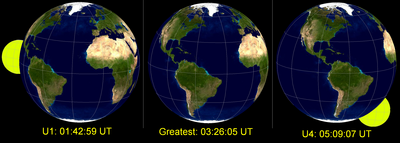 These simulated views of the Earth from the center of the Moon during the lunar eclipse show where the eclipse is visible on Earth. |

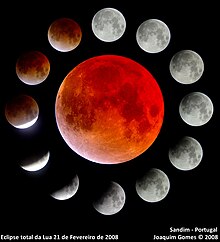 Eclipse observed from Sandim, Portugal. 41°02′22″N 8°30′50″W. |
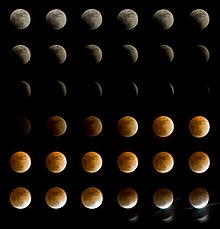 Eclipse observed from Regina, Saskatchewan. Each image is roughly taken 5 minutes apart. |
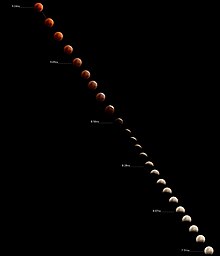 Images taken in 3-5 minute Intervals - from Bradley, Illinois. |
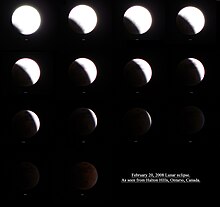 Eclipse observed from Halton Hills, Ontario. From 01:47 to 03:15 UTC, each image is roughly taken 5min apart. |
Eclipse observed from Winnipeg, Manitoba | |
Lunar eclipse observed from Burlington, Ontario | |
 Observed from Baltimore, Maryland, from 2:30 to 3:01 UTC. Lunar north is near left. | |
Shown below is a table displaying details about this particular solar eclipse. It describes various parameters pertaining to this eclipse.[6]
| Parameter | Value |
|---|---|
| Penumbral Magnitude | 2.14698 |
| Umbral Magnitude | 1.10809 |
| Gamma | -0.39923 |
| Sun Right Ascension | 22h15m30.0s |
| Sun Declination | -10°48'31.3" |
| Sun Semi-Diameter | 16'10.5" |
| Sun Equatorial Horizontal Parallax | 08.9" |
| Moon Right Ascension | 10h14m48.5s |
| Moon Declination | +10°28'07.6" |
| Moon Semi-Diameter | 15'34.2" |
| Moon Equatorial Horizontal Parallax | 0°57'08.5" |
| ΔT | 65.5 s |
This eclipse is part of an eclipse season, a period, roughly every six months, when eclipses occur. Only two (or occasionally three) eclipse seasons occur each year, and each season lasts about 35 days and repeats just short of six months (173 days) later; thus two full eclipse seasons always occur each year. Either two or three eclipses happen each eclipse season. In the sequence below, each eclipse is separated by a fortnight.
| February 7 Ascending node (new moon) | February 21 Descending node (full moon) |
|---|---|
 |  |
| Annular solar eclipse Solar Saros 121 | Total lunar eclipse Lunar Saros 133 |
| Lunar eclipse series sets from 2006–2009 | ||||||||
|---|---|---|---|---|---|---|---|---|
| Descending node | Ascending node | |||||||
| Saros # and photo |
Date Viewing |
Type Chart |
Gamma | Saros # and photo |
Date Viewing |
Type Chart |
Gamma | |
113 |
2006 Mar 14 |
penumbral |
1.0211 | 118 |
2006 Sep 7 |
partial |
−0.9262 | |
123 |
2007 Mar 03 |
total |
0.3175 | 128 |
2007 Aug 28 |
total |
−0.2146 | |
133 |
2008 Feb 21 |
total |
−0.3992 | 138 |
2008 Aug 16 |
partial |
0.5646 | |
143 |
2009 Feb 09 |
penumbral |
−1.0640 | 148 |
2009 Aug 06 |
penumbral |
1.3572 | |
| Last set | 2005 Apr 24 | Last set | 2005 Oct 17 | |||||
| Next set | 2009 Dec 31 | Next set | 2009 Jul 07 | |||||
This lunar eclipse is part of series 133 of the Saros cycle, which repeats every 18 years and 11 days. Series 133 runs from the year 1557 until 2819. The previous eclipse of this series occurred on February 9, 1990, and the next will occur on March 3, 2026.
It is the 6th of 21 total lunar eclipses in series 133. The first was on December 28, 1917. The last (21st) will be on August 3, 2278. The longest two occurrences of this series (14th and 15th) will last for a total of 1 hour and 42 minutes on May 18, 2152, and May 30, 2170. Solar saros 140 interleaves with this lunar saros with an event occurring every 9 years 5 days alternating between each saros series.
Lunar saros series 133, repeating every 18 years and 11 days, has a total of 71 lunar eclipse events including 54 umbral lunar eclipses (33 partial lunar eclipses and 21 total lunar eclipses).
| Greatest | First | |||
|---|---|---|---|---|
The greatest eclipse of the series will occur on 2170 May 30, lasting 102 minutes. |
Penumbral | Partial | Total | Central |
| 1557 May 13 |
1683 Aug 07 |
1917 Dec 28 |
2098 Apr 15 | |
| Last | ||||
| Central | Total | Partial | Penumbral | |
| 2224 Jul 01 |
2278 Aug 03 |
2429 Dec 11 |
2754 Jun 26 | |
There are 10 series events between 1901 and 2100, grouped into threes (called an exeligmos), each column with approximately the same viewing longitude on Earth.
| 1917 Dec 28 | 1936 Jan 08 | 1954 Jan 19 | |||
 |
 |
 |
 |
 |
 |
| 1972 Jan 30 | 1990 Feb 09 | 2008 Feb 21 | |||
 |
 |
 |
 |
 |
 |
| 2026 Mar 03 | 2044 Mar 13 | 2062 Mar 25 | |||
 |
 |
 |
 |
||
| 2080 Apr 04 | 2098 Apr 15 | ||||
 |
 |
 |
 | ||
This is the fourth of five Metonic lunar eclipses.
The Metonic cycle repeats nearly exactly every 19 years and represents a Saros cycle plus one lunar year. Because it occurs on the same calendar date, the Earth's shadow will in nearly the same location relative to the background stars.
| Descending node | Ascending node | |||||
|---|---|---|---|---|---|---|
| Saros | Date | Type | Saros | Date | Type | |
| 103 | 1951 Feb 21.88 | Penumbral | 108 | 1951 Aug 17.13 | Penumbral | |
 |
 | |||||
| 113 | 1970 Feb 21.35 | Partial | 118 | 1970 Aug 17.14 | Partial | |
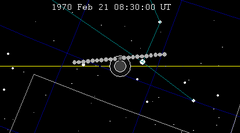 |
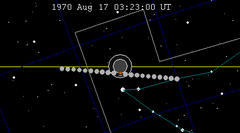 | |||||
| 123 | 1989 Feb 20.64 | Total | 128 | 1989 Aug 17.13 | Total | |
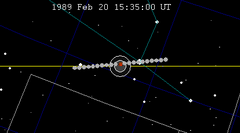 |
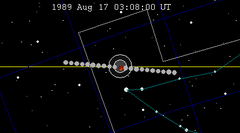 | |||||
| 133 | 2008 Feb 21.14 | Total | 138 | 2008 Aug 16.88 | Partial | |
 |
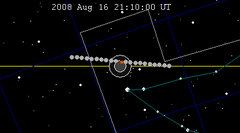 | |||||
| 143 | 2027 Feb 20.96 | Penumbral | 148 | 2027 Aug 17.30 | Penumbral | |
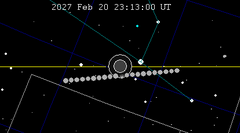 |
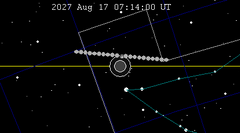 | |||||
A lunar eclipse will be preceded and followed by solar eclipses by 9 years and 5.5 days (a half saros).[8] This lunar eclipse is related to two annular solar eclipses of Solar Saros 140.
| February 16, 1999 | February 26, 2017 |
|---|---|
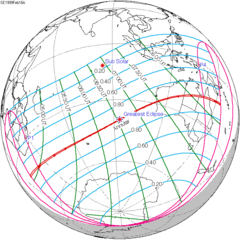 |
 |
Seamless Wikipedia browsing. On steroids.
Every time you click a link to Wikipedia, Wiktionary or Wikiquote in your browser's search results, it will show the modern Wikiwand interface.
Wikiwand extension is a five stars, simple, with minimum permission required to keep your browsing private, safe and transparent.